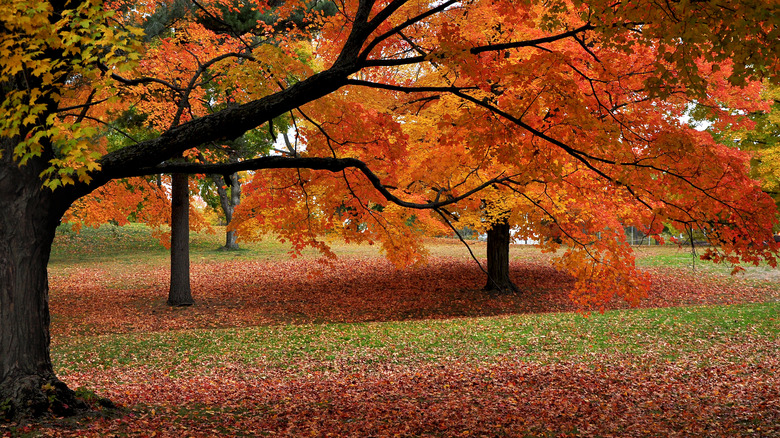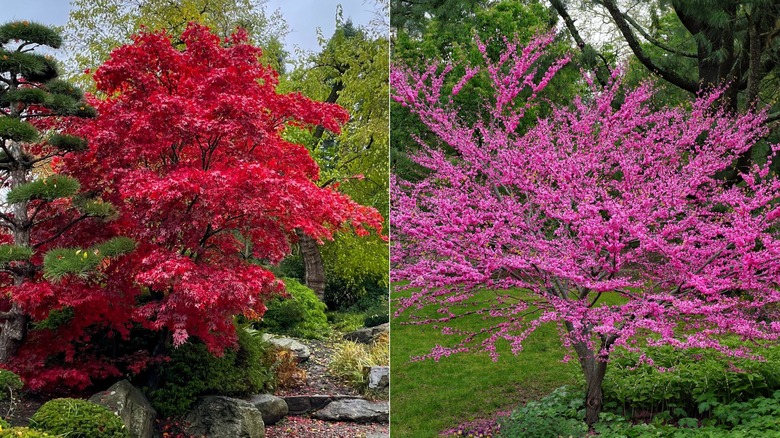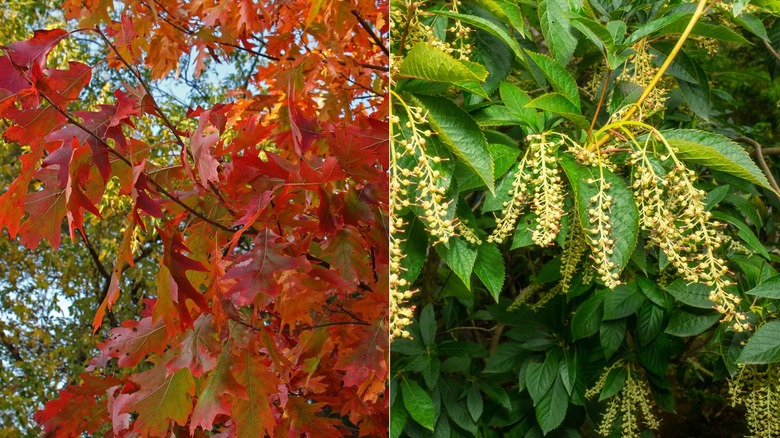Better Alternatives To Grow Instead Of The Invasive Chinese Tallow Tree
Although it's been a popular ornamental tree thanks to its fast growth and attractive foliage color in the fall, the Chinese tallow tree (Triadica sebifera) should be avoided, especially if you live in North Carolina, Florida, California, Oklahoma, Texas, Arkansas, and Georgia, where it's classified as an invasive species. The tree roots spread readily and produce suckers that will grow into new trees. Although birds adore this tree, it does come with some major problems. The birds will consume the seeds and then drop them into other areas where they will germinate. Another issue is that it will invade undisturbed forests and shaded areas and crowd out native trees. It can also change the soil chemistry because it contains high amounts of tannins in its leaves.
But if you love the form and fall color that this tree can provide, there are plenty of alternatives that you can grow, all of which are native species and not invasive. Some of these include maples, redbuds, black gums, sourwoods, and oaks. All of these trees fill a similar niche in your garden and can provide you with lovely summer shade and stunning fall color.
Plant maples or redbuds instead of the Chinese tallow
Maples are prized for their gorgeous fall foliage and their lovely shape. There are numerous species that are native to the U.S. including the red maple (Acer rubrum) and the sugar maple (Acer saccharum). Both of these species are deciduous, which means their leaves will change color in the fall to brighten up your garden. They're also tall growing trees to provide plenty of shade in summer. The red maple can reach a height of 70 to 75 feet while the sugar maple can grow as high as 80 feet. Red maples can be grown in USDA hardiness zones 2 through 9 while sugar maples will grow happily in USDA hardiness zones 3 through 8. You might also want to explore other stunning maple trees that will add drama to your yard.
Another tree you could consider growing instead of the Chinese tallow is the Eastern redbud (Cercis canadensis). This outstanding deciduous tree will thrive in USDA hardiness zones 4 through 9 and can reach a height of up to 30 feet. It features a lovely rounded crown and produces masses of pink to purple blooms in early spring. These stunning blooms will have pollinators flocking to your garden, and the birds will adore the bean pods that follow the flowers. In the fall, the redbud will delight you when the leaves turn a beautiful golden yellow color before falling off the tree.
Magnificent oaks and stunning sourwoods are another good choice
To create an outstanding statement in your yard, you simply can't walk past the magnificent oak tree. One of the best specimens is the northern red oak (Quercus rubra) which can reach a height of up to 75 feet. It can be grown in USDA hardiness zones 4 through 8 and is particularly useful for supporting wildlife, including the larvae of the imperial moth and birds such as woodpeckers and blue jays. The acorns are also a good food source for small mammals. In fact, the oak is a common tree that'll attract all kinds of beautiful butterflies to your yard. It's an excellent shade tree in summer and will present beautifully with its reddish-brown foliage in the fall. But, if you have a smaller yard that can't support this stunning tree, you could consider growing the dwarf chestnut oak (Quercus prinoides) instead. This lovely tree only reaches a maximum height of up to 20 feet and can be grown in USDA hardiness zones 5 through 8.
Another tree you might want to consider is the sourwood (Oxydendrum arboreum) which produces lovely fragrant white flowers on long panicles in mid-summer that will attract bees to your garden. This attractive tree can reach a height of up to 30 feet and grows happily in USDA hardiness zones 5 through 9. The beautiful glossy green leaves turn a head-turning bright red in the fall for an outstanding display of color.


